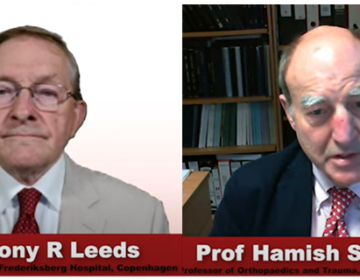Health chat with Dr. Anthony R Leeds| Interview with Professor Mike Lean, University of Glasgow
In this interview Professor Lean begins by explaining how people with type 2 diabetes often have other weight-related conditions such as obstructive sleep apnoea (OSA) which is where breathing stops due to temporary collapse of the breathing tube (the airway) during sleep and then restarts. People with OSA snore loudly and may gasp and choke during sleep. They may wake up a lot, feel tired even after a full night of sleep and may have headaches, be unable to concentrate well and may feel depressed. They may also fall asleep during the daytime at times when they should stay awake.
Pakistan is one of the top ten countries for high numbers of people with obstructive sleep apnoea. In a 2019 publication reporting surveys done from 2001-2018 (see below) Pakistan is believed to have 25 million people (39% of adults aged 30-69 years) with mild sleep apnoea and 17 million (27% of adults aged 30-69 years) with moderate and severe sleep apnoea. Thus, two in every three adults have some degree of sleep apnoea.
After losing weight people with this form of sleep apnoea are often much improved and may also gain a benefit in reduction of high blood pressure as well as reduced severity of daytime sleepiness and other symptoms. Since sleep apnoea can also affect driving ability through tendency to fall asleep at the wheel some drivers can lose their employment as a result of untreated obstructive sleep apnoea. Those who drive for leisure or employment purposes while suffering from sleep apnoea can be a hazard for other road users. Weight loss is one of several diet and lifestyle changes that can be made for obstructive sleep apnoea (see web-links below) but often people are not offered effective weight loss solutions. The type of diet and lifestyle approach used in the direct trial to achieve remission as described by Prof Lean in episode two of this series has been shown in studies in Sweden and Finland to significantly improve the symptoms of sleep apnoea, and reduce the number of episodes when breathing stops.
Asked if weight loss can be beneficial in other lung conditions, Prof Lean referred to a recent study undertaken in Glasgow that showed the benefit of weight loss in difficult to treat asthma. More work needs to be done to demonstrate the benefits of weight loss in lung diseases but ten per cent weight losses achieved with formula diet programs, as used in the Direct trials, show great promise.
Dr Leeds noted that in the direct trial some of the participants had liver scans that showed big reductions in liver fat: greater weight losses and better weight maintenance gave larger liver fat reductions and better maintenance of lower liver fat, in turn giving a greater proportion of people in remission and a better maintenance of their remission status. Since fatty liver (non-alcoholic fatty liver disease) and the subsequent liver fibrosis seen in obesity is increasingly common, Dr Leeds asked if there was a place for the Direct type of diet in this type of fatty liver condition. Prof Lean discussed the evidence from Direct and other studies that show the effects of weight loss in fatty liver disease.
Concluding by considering other conditions that are linked with obesity Prof Lean noted that where an individual has several different conditions losing weight may be of benefit in all of these, including reduced high blood pressure, better sleep, reduced pain in osteoarthritis, as well as benefits for those with diabetes.
Viewers and readers who are concerned about their family history of diabetes and their rising body weight can check their risk on-line by using risk calculators (see links below). Those at high or intermediate risk are advised to consult a doctor to ask for a blood test and discuss their concerns.
Those who believe they may be affected by other obesity related conditions can use online risk assessment tools and seek medical and health care guidance on what to do next.
Web-links to useful sources of information are given below.
—ooOOoo—
—ooOOoo—
Diabetes prevention:
The Canadian Diabetes Risk calculator:
The Indian Diabetes risk score:
UK Type 2 diabetes – know your risk
—ooOOoo—
Obstructive Sleep apnea:
Canada
What Impact Sleep Apnea on Canadians
USA:
UK
Sleep Apnoea
Online Assessment:
Epworth Sleepiness Scale for Sata
Stop Bang Questionnaire Aug-2021
Pakistan
OSA Guideline 2020
India
—ooOOoo—
Fatty liver disease
Canada
USA
Non Alcoholic Fatty Liver Disease Nafld / Facts at a Glance
UK
Non Alcoholic Fatty Liver Disease
Non Alcoholic Fatty Liver Disease link 2
Prevalence in South Asia
Full text
Pakistan
India
World Liver day Non Alcoholic Fatty Liver Disease
India have Fatty Liver Disease Doctors
—ooOOoo—
Diabetes remission:
Research Spotlight Low Calorie Liquid Diet
Long term (5 year) results of Diabetes remission trial:
—ooOOoo—















